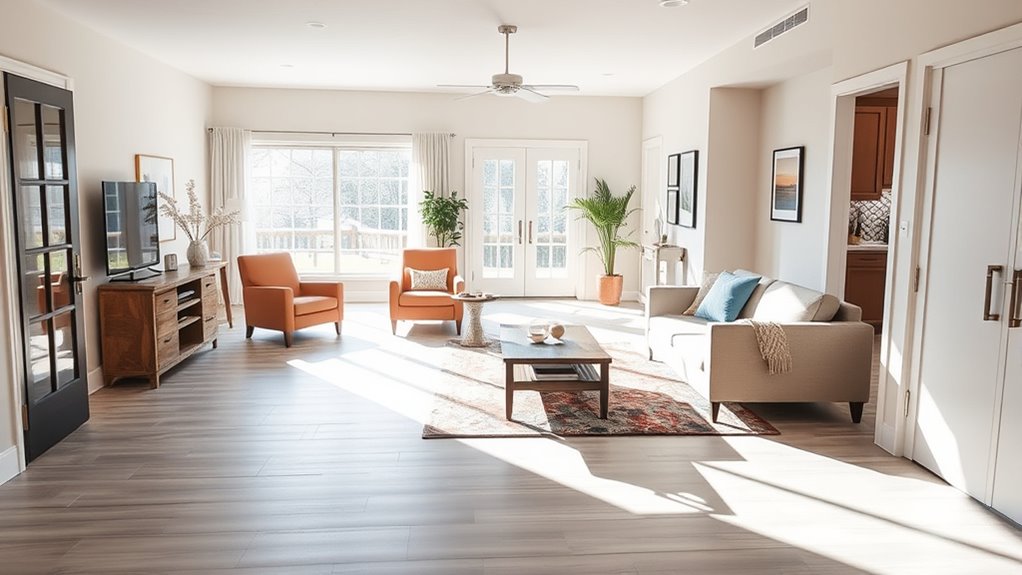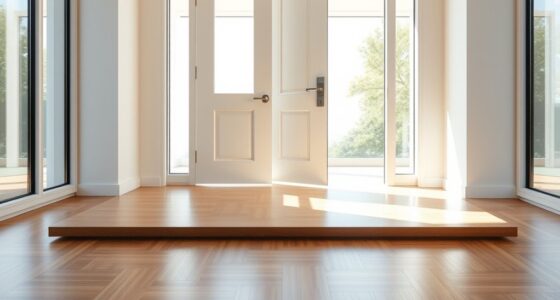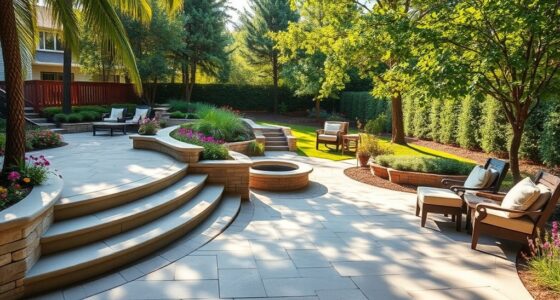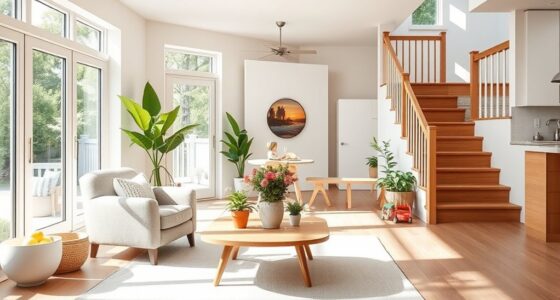Age-friendly design is transforming homes into adaptable spaces where safety, comfort, and independence are prioritized for everyone. By incorporating universal features like wide doorways, non-slip floors, and smart technology, you can make your living environment safer and more accessible. Smart homes offer automation and intuitive controls that support changing needs. If you keep exploring, you’ll discover how these innovations can help you create a truly livable space for all ages and stages of life.
Key Takeaways
- Universal design creates adaptable, safe, and accessible environments suitable for people of all ages and abilities.
- Incorporating smart technology and simple modifications enhances independence and safety in home environments.
- Features like wide doorways, non-slip floors, and automated lighting improve mobility and reduce fall risks.
- Age-friendly homes prioritize comfort, durability, and safety through innovative design and adaptive features.
- The universal design revolution promotes inclusive living spaces that support active aging and lifelong independence.

Have you ever considered how the design of our environment impacts the aging population? As you plan or modify your living space, understanding the role of age-friendly design becomes essential. A smart home equipped with adaptive technology can transform everyday living, making it safer, more comfortable, and accessible for everyone, regardless of age or ability. These innovations aren’t just about convenience; they’re about creating environments that adapt to your changing needs, promoting independence and peace of mind.
Imagine walking into a home where lights automatically brighten when you enter a room or where thermostats adjust to maintain a comfortable temperature. These are examples of adaptive technology, which is at the heart of age-friendly design. It enables your environment to respond intelligently to your behaviors and preferences, reducing hazards and eliminating unnecessary effort. Smart homes incorporate sensors, voice-activated controls, and automated systems that can be tailored to individual needs, making daily routines simpler and safer. For example, voice commands can turn on appliances or check security cameras, eliminating the need to reach for switches or navigate complex controls.
Designing with adaptability in mind means considering how spaces can evolve as your needs change. Wide doorways, non-slip floors, and minimal thresholds make mobility easier and reduce fall risks. These features benefit everyone—whether you’re aging in place or welcoming visitors of all ages. Smart home technology further enhances this flexibility; for instance, automated lighting can guide you safely through your home at night, and remote monitoring can alert caregivers to potential issues before they escalate. Such features foster independence while providing reassurance that help is readily available if needed.
The integration of adaptive technology is not limited to high-tech gadgets. Simple modifications, like adjustable countertops or lever-style door handles, combined with smart automation, make homes more livable for all. As you consider age-friendly design, think about how these elements can be incorporated seamlessly. The goal is to create a space that’s intuitive, safe, and supportive—one that promotes active living and reduces barriers. By embracing smart home features and adaptive technology, you’re not just making your home more accessible; you’re investing in a sustainable environment that accommodates life’s inevitable changes.
Furthermore, incorporating water resistance features found in waterproof running watches exemplifies how durable, reliable design supports safety and peace of mind, which are crucial elements in age-friendly environments. Ultimately, age-friendly design isn’t just a trend; it’s a necessary evolution in how we think about living spaces. It puts your safety, comfort, and independence at the forefront, ensuring your home remains a sanctuary through all stages of life. The smart home revolution and adaptive technology empower you to customize your environment, making aging more manageable and enriching your everyday experience.
Frequently Asked Questions
How Does Universal Design Impact Home Resale Value?
Universal design can boost your home’s resale value by increasing its market appeal. When your home includes features that cater to all ages and abilities, it appeals to a broader range of buyers. This enhances your home equity, making it more attractive and easier to sell. Buyers see the practicality and longevity of universal design, which often results in a quicker sale at a better price, benefiting you financially.
Are Age-Friendly Features Customizable for Individual Needs?
You can customize age-friendly features to suit your individual needs by exploring various personalization options. Many adaptive solutions are designed for flexibility, allowing you to modify features like grab bars, lighting, or door thresholds easily. This guarantees your home stays comfortable and functional as your needs change. By choosing adaptable designs, you create a more inclusive environment that promotes independence and safety, tailored perfectly to your lifestyle.
What Are Cost-Effective Ways to Retrofit Existing Homes?
Imagine saving money, enhancing safety, and increasing comfort all at once. You can achieve this through cost-effective retrofits like installing grab bars, adding non-slip flooring, and improving lighting. DIY retrofits allow you to customize solutions, save on labor costs, and quickly adapt your home to your needs. These simple updates create a safer environment, boost your independence, and provide long-term cost savings, making your home more livable for all ages.
How Do Outdoor Spaces Integrate Into Age-Friendly Designs?
You can enhance outdoor spaces by focusing on landscape integration and outdoor accessibility. Facilitate pathways are smooth, wide enough for mobility aids, and free from tripping hazards. Incorporate sitting areas, shade, and ramps to make outdoor areas inviting and easy to navigate. Thoughtful landscape design creates seamless progressions between indoor and outdoor spaces, promoting independence and safety for all ages. This approach helps make your outdoor environment more inclusive and functional.
What Are Common Misconceptions About Universal Design Benefits?
You might believe misconceptions myths about universal design benefits, thinking it’s only for seniors or people with disabilities. However, many benefit misunderstandings exist—universal design enhances safety, comfort, and accessibility for everyone, regardless of age or ability. It’s not just an adaptation but a smart choice that promotes independence and convenience. Don’t let myths limit your understanding; universal design truly creates more inclusive, functional living spaces for all.
Conclusion
By embracing age-friendly design, you create spaces that gracefully adapt to life’s changes, making your home more welcoming for everyone. It’s like planting a garden that blooms year-round, offering comfort and ease as you go through different seasons of life. With thoughtful touches, you guarantee your home remains a safe haven, nurturing independence and connection. Ultimately, these designs subtly weave comfort into everyday living, allowing you to enjoy every moment with peace of mind.









